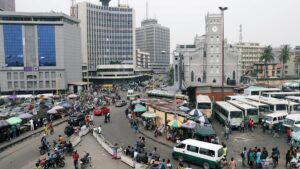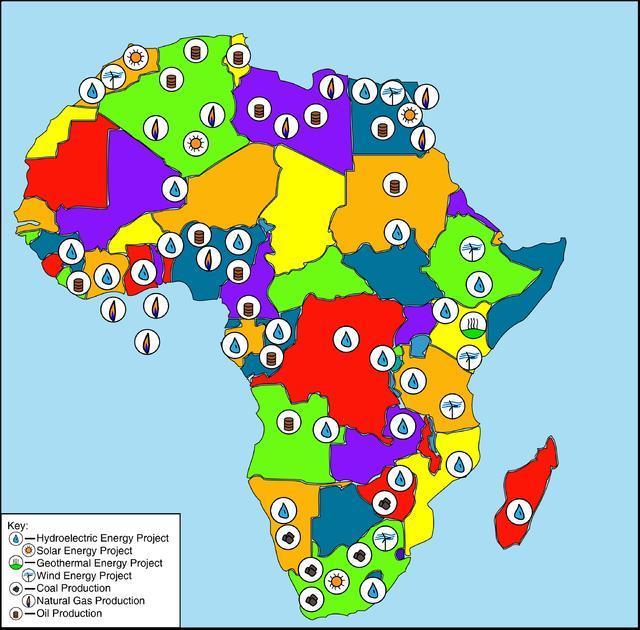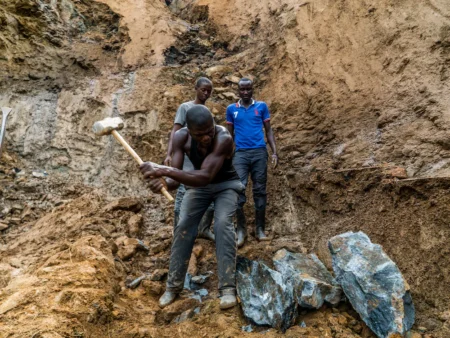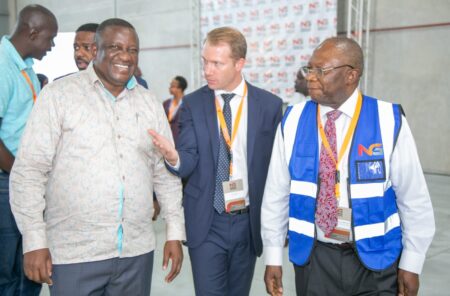As Africa’s role in the global economy continues to garner prominence, it’s imperative for the continent to seal the gaping hole in its power supply.
Lack of universal power access remains a major roadblock that has retrogressed industrialization and socio-economic development. Statistics from the World Bank indicate that Africa remains the least electrified region in the world, with 568 million people lacking access to electricity.
The Bretton Woods institution, further notes that the Sub-Saharan Africa’s share of the global population without electricity, jumped to 77 per cent in 2020 from 71 per cent in 2018, whilst most regions saw declines in their share of access deficits. It has become a Hobson’s choice for African governments to prioritize the power sector, which is the epicenter of industrialization, working towards Goal 7 of the UN SDGs; which advocates for universal access to affordable, reliable and modern electricity services.
Currently, Africa’s power is generated from a mix of biomass estimated at 50 per cent, oil at 22 per cent, coal at 14 per cent and natural gas at 14 per cent. Africa has the golden opportunity to leapfrog traditional fossil-fueled based energy supplies, to achieve a robust renewable energy mix. Over-reliance on fossil fuels have failed to sufficiently meet the needs of African countries, calling for alternative energy sources by governments.
Can renewable energy sources sufficiently satisfy Africa’s power demands? The answer is YES and it’s the continent’s safest bet, given its vulnerability to effects of climate change; despite contributing the least greenhouse gas (GHG) emissions globally, of a paltry 4 per cent. According to the International Energy Agency (IEA), renewables which comprise of solar, wind, geothermal energy and hydropower; can make up four-fifth of the continent’s power generation capacity by the end of the decade. Unlocking sustainable, economic and social development through renewables is the key to Africa’s future.
The African Development Bank (AfDB), has been committed to pursuing the new energy deal for Africa. Launched in 2016, the deal targets to achieve universal energy access, with priority given to low-carbon technologies which harness abundant, hydro, solar, wind and geothermal resources of the continent. During the recently held AfDB annual meetings in Ghana, the Bank renewed its commitment towards the High 5s which include ‘Lighting up and Powering Africa’; key pillars of the Banks strategic outlook for the next ten years 2023 to 2032.
Some countries have emerged as frontrunners in electrifying their nations. Egypt is a good example being a leader in the renewable energy sector; the North African country has achieved a 100 per cent national electricity access rate, for both the rural and urban population. In the same breath, Morocco and Tunisia boast of similar statistics. Other countries ranking among the top include Algeria, Gabon, South Africa, Kenya, Ghana and Senegal.
According to the World Health Organization (WHO), only 28 per cent of health facilities in Sub-Saharan Africa have access to affordable and reliable power. In response to this dire need, Power Africa collaborates with African governments and the private sector; to expand access to electricity to health facilities across the region. ‘Power Africa’ is an American initiative, that was launched by the then US President Barack Obama in Tanzania, during his Africa Tour in 2013; with an aim to support economic growth and development by increasing access to reliable, affordable and sustainable power in Africa.
The Power Africa Off-Grid Project has awarded US$3,070,650 in grant funding, to electrify more than 250 health facilities in ten countries in Sub-Saharan Africa. In October 2021, Power Africa transferred US$500,000 of Maternal Child Health funding, to electrify seven large health facilities in Uganda and Malawi, using solar energy installations. During the 2021 UN High–level Dialogue on Energy, Power Africa joined more than a dozen organizations to launch a Multilateral Energy Compact for Health Facility Electrification; with a goal to electrify 25,000 health facilities with clean and reliable power solutions by 2025.
Ongoing renewable energy projects in Africa
2021 recorded the launch of large-scale projects across the continent that will aid in powering Africa. For instance, the Government of Namibia launched the country’s first large-scale green hydrogen project, estimated to cost US$9.4 billion, to help position the country as a green hydrogen economy. The first phase is expected to enter production in 2026, and will create 2GW of renewable electricity generation, with capacity increasing to 5GW within further expansion phases.
The Chollet Hydroelectric Power Station, a joint project by both Congo and Cameroon, upon completion in 2025, is estimated to have a production capacity of 600MW; which will provide electricity for both countries. A concession agreement was signed by the two countries and a Chinese company for the construction of the US0 million hydroelectric station on Dja River. (Tramadol The Democratic Republic of Congo’s state-owned power utility, SNEL signed power purchase agreements for two solar plants, with an estimated capacity of 100MW each, in Kolwezi and Likasi located in the copper belt region of the country. The former estimated at cost of US$148M whilst the latter at US$157M respectively.
South Africa’s Mogalakwena solar photovoltaic plant, is another renewable project estimated to produce 100MW.The country additionally launched the fifth bid window of the Renewable Energy Independent Power Producer Procurement Program; which aims to procure an estimated 2,600MW of renewable energy, of this, 1600MW comprises onshore wind and 1000MW solar. Bostwana also launched the Shumba Energy Solar Project, estimated to produce 100MW; it will be the largest in the country, as it seeks to eliminate dependence of fossil fuels and transition to renewable energy sources. Ghana announced plans to construct eight solar plants, expected to produce 10 to 100MW each, and will be tied into the National Interconnected Transmission System.
State of Africa’s renewables
- Harnessing Africa’s wind power
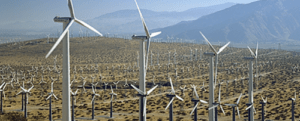 The Lake Turkana Wind Power Project.Source-AfDB
The Lake Turkana Wind Power Project.Source-AfDB
As Africa continues to explore renewable power generation resources, wind power makes part of the clean energy transition, and wields massive potential, to help seal the power deficit in the continent. Both onshore and offshore wind power is capable of delivering lower-cost power, as opposed to fossil fuels. A recent report commissioned by the International Finance Corporation (IFC), on ‘Wind Energy; Joining Forces for an African Lift-Off,’ indicated that Africa has 59,000 GW of technical onshore and offshore wind potential, which is enough to meet the continent’s energy demand 250 times over.
The Global Wind Energy Council (GWEC) notes that Africa is only using 0.01 per cent, of the 59,000 GW. In late 2021, GWEC, with support from numerous entities such as International Energy Agency (IEA), the International Renewable Energy Agency (IRENA), IEA, IFC; launched Africa Wind Power (AWP); a regional body representing the wind industry, with a goal to scale up and accelerate wind projects across the continent. In 2020, the installed capacity of windfarms stood at 6.5MW, this figure only represents a fraction of the continent’s wind potential.
Renowned wind power markets include South Africa, Morocco, Egypt, Kenya and Ethiopia. Some of the prominent windfarms in Africa include; the Lake Turkana windfarm in Kenya producing 310 MW of reliable, low-cost energy, estimated as sufficient to power one million homes. In addition, Kenya’s Kipeto windfarm generates 100MW. Morocco’s Tarfaya produces 301MW; Egypt’s Ras Ghareb generates 262.5 MW and West Bakr project contributes 250MW; Ethiopia’s Adama produces 204MW; Senegal’s Taiba N’diaye generates 158MW; South Africa’s Kangnas and Khobab contribute 140MW each; Mauritania’s Boulenouar produces 102MW.
- Tapping Africa’s hydroelectric power
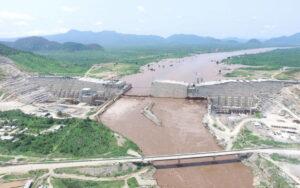
The Grand Ethiopian Renaissance Dam,the largest HEP project in Africa. Source-ANA
Africa boasts vast hydroelectric power (HEP) resources, with immense potential for increased power generation to power the continent. Just recently, in cognizance of the massive potential of the sector; the British Prime Minister Boris Johnson was in Rwanda to meet Commonwealth leaders, and announced that the UK will offer £160 million, for hydropower in Africa, to help economies on the continent. 21 countries in Sub-Sahara Africa have a total generation capacity of less than 200MW. South Africa takes the lead, generating 45 per cent of the continent’s production, North African countries follow suit at 30 per cent, whilst the rest of the continent cumulatively take up 25 per cent. Cameroon, Guinea, DRC, Sudan, Mozambique and Angola, have noteworthy HEP resources, of which currently only 7 per cent are developed.
The controversial Grand Ethiopian Renaissance Dam (GERD) project, Ethiopia’s multibillion dollar hydro plant located on the Nile River, started generating electricity in February 2022 and is currently 83.9 per cent complete. Hailed as the biggest hydropower plant in Africa, the dam is set to generate 5150MW upon completion, it will not only transform Ethiopia but also its neighbours.
Ethiopia is ranked as the second most populous country in Africa, yet two-thirds of the population is without power. The mega-hydropower plant, will spur economic growth and development in Ethiopia and the wider region. In light of this, Ethiopia recently signed an MoU with South Sudan to export hydropower, starting with an initial 100MW over the next three years. Similarly, it has an agreement to sell to Kenya and Tanzania, with plans to also supply to Rwanda, Burundi and Somalia. In total, the country exports 254MW of electricity, to neighbouring Sudan and Djibouti.
Other Africa’s HEP projects include: Egypt’s High Aswan dam; Grand Inga Project I, II, III; the Mphanda-Nkuwa project in Mozambique; Ruzizi projects I, II, III on the Ruzizi River bordering DRC and Rwanda; Uganda’s Bujagali HEP Plant; Ghana’s Bui HEP Plant; Zambia’s Kafue Gorge HEP; Regional Rusumo dam serving Rwanda, Burundi and Tanzania as part of the Great Lakes Initiative; Morocco’s El Menzel projects.
-
Extracting the potential of Africa’s geothermal power
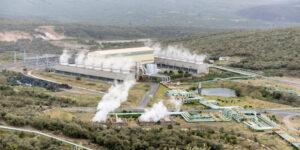
Kenya’s Geothermal Power Plant in Olkaria.Source-Afrik 21
Africa possesses vast untapped geothermal potential, which if explored could be largely among the renewable solutions Africa needs, to solve the power shortage quagmire. The continent’s geothermal potential is said to be in the Great Rift Valley, a geologically active area known to have over thirty active volcanoes and numerous hot springs, extending from Djibouti to Mozambique. Currently, Kenya is the largest geothermal producer in Africa, with an installed capacity of 863MW and ranks ninth in the world, with power production contributing to over 40 per cent of the country’s electricity generation.
Relishing this position, the country’s energy production company KenGen, wants to offer bitcoin mining companies its surplus geothermal power, to assist in meeting their energy needs.
The country has an estimated geothermal potential of 10,000MW, spread along the Rift Valley circuit. Data from the Energy and Petroleum Regulatory Authority, shows that geothermal is the biggest contributor of power to the national grid, accounting for 44.12 per cent of the total supply followed by hydropower at 26.98 per cent.
According to the Infrastructure Consortium for Africa and the United Nations Environment Program; several countries across Eastern Africa such as Uganda, Rwanda, Djibouti, Tanzania, Comoros and Eritrea; have an estimated potential of 20,000MW, and have been undertaking preliminary exploration for geothermal potential. Zambia, Burundi, Ethiopia and Uganda operate small-scale geothermal plants.
Another project that has helped reduce high power tariffs in Kenya is the Sosian Menengai Geothermal Power in Nakuru; with a capacity to produce enough electricity to serve almost 500,000 homesteads and 300,000 businesses. Kenya has a target to hit 5GW geothermal capacity by 2030.Lack of technical expertise and adequate funding, as the cost of exploration is high; are some of the critical challenges that geothermal exploration in Africa encounters.
-
Off Grid Solar Power Transforming Lives in Africa
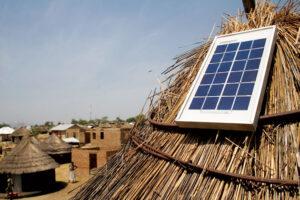
Off-Grid Solar Energy lighting up Africa’s remote villages.Source-Bloomberg
Solar energy has been revolutionary for many users in Africa, with countries across the continent reaping socio-economic benefits pertinently from off-grid electricity, which has been swiftly gaining momentum, with the market growing rapidly. According to GOGLA, the off-grid solar association, in the second half of 2019, 2.43M units of off-grid solar products were sold in East Africa alone. Solar renewable energy is highly recommended to combat climate change as it is carbon free.
The sector has been attracting heavy investments such as the recent one to Benin by the European Investment Bank (EIB), one of the world’s largest financiers of renewable energy, in partnership with ENGIE Energy Access. Communities across Benin will be able to access reliable and cheap electricity for the first time, thanks to a new off-grid solar scheme, funded by the Bank which has disbursed a EUR 10M loan; to support the deployment of 107,000 high-quality solar home systems to Benin, opening up access to clean energy for 643,000 people. Solar power in Africa minimizes the usage of kerosene, charcoal and reduces pollution. Benin makes for the sixth African country, to benefit from EIB unparalleled support for African off-grid energy investment; with the others having been in Uganda. Chad, Mozambique, Comoros and DRC.
The World Bank project dubbed, ’Lighting Africa Program’, which is part of the Bank’s ‘Sustainable Energy for All’ initiative, a mandate to bring energy to the planet by 2030; has seen 32 million Africans gain access to energy, often through off-grid solar products. In addition, Lighting up Africa through solar energy, is a pillar of the Banks’s Africa Climate Business Plan (ACBP), with ambitious programs across the continent scaling up every year. Currently, the Bank is the largest financier in this sector, supporting about 25 per cent of mini grid investments in the developing world. The US$220M Ghana Energy and Development Access Project (GEDAP), is among the first Bank-financed programs, to focus on inclusive access to renewable energy through off-grid solar services and products. The project included five pilot mini-grids that converted solar energy to electricity, for isolated communities in the islands around Lake Volta; providing electricity to about 10,000 beneficiaries. Similarly, the bank has supported solar projects and programs in other countries in West Africa and the Sahel region including Burkina Faso, Togo, Guinea, CAR, Sierra Leone, Niger, Mali, Mauritania, Chad, Cameroon, Cote d’Ivoire, Gambia, and Senegal among others.
-
Africa’s budding green hydrogen industry gaining prominence
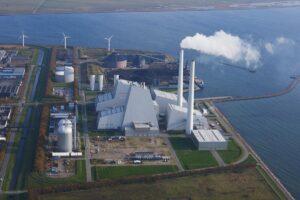
The Boegoebaai Hydrogen Power Project in South Africa.Source-CR-Nysted Luftfoto.
Africa’s green hydrogen sector is growing steadily and could soon be exporting green hydrogen, to meet rising demand in Europe among other markets. Presently, various projects are underway albeit in the early stages of development. Mauritania, Egypt, Morocco, South Africa, Niger and Namibia, have set up plans for hydrogen production facilities. For instance, Egypt has at least five green hydrogen projects in the pipeline, one is feedstock for the production of green ammonia.
Africa stands to gain a plethora of benefits from the development of green hydrogen, which include its domestic use to generate power, industrial purposes, and job creation among others. In September 2021, Mauritania signed an MoU for the development of Project Nour, projected to provide 10GW of renewable energy for green hydrogen development. Niger is also keen to take advantage of its abundant Saharan solar resources, to power green hydrogen.
South Africa has been among the Sub-Saharan countries keen to promote the hydrogen fuel cell sector, as it holds more than 90 per cent of the world’s deposits of platinum, a key component in fuel cells. Sasol, one of the country’s energy firms announced it intends to commence producing 6 tonnes a day of green hydrogen by 2023, using 60MW of renewable electricity. The project is estimated to produce up to 400,000 tonnes, based on 9GW of renewable electricity at a cost of US$10B. In November 2021, Namibia set out to develop the country’s first large-scale green hydrogen project, at a cost of US$4.4B, with the first phase projected to produce up to 300,000 tonnes a year of green hydrogen, powered by 2GW capacity of renewable electricity by 2026.
Morocco announced its intention to establish the development of a global hub for green hydrogen, at the heart of its industrial strategy. With the first production forecast for 2027, the US$10B green hydrogen and ammonia development, will come from 10 GW of wind and solar power generation. Due to its proximity to markets across the Mediterranean to Europe; North Africa is best positioned to deliver large-scale green hydrogen projects. As the continent braces for a low carbon future, it needs to pool adequate investments towards renewables, to scale up the universal access of clean electricity to avert climate disasters, thereby securing Africa’s future.


